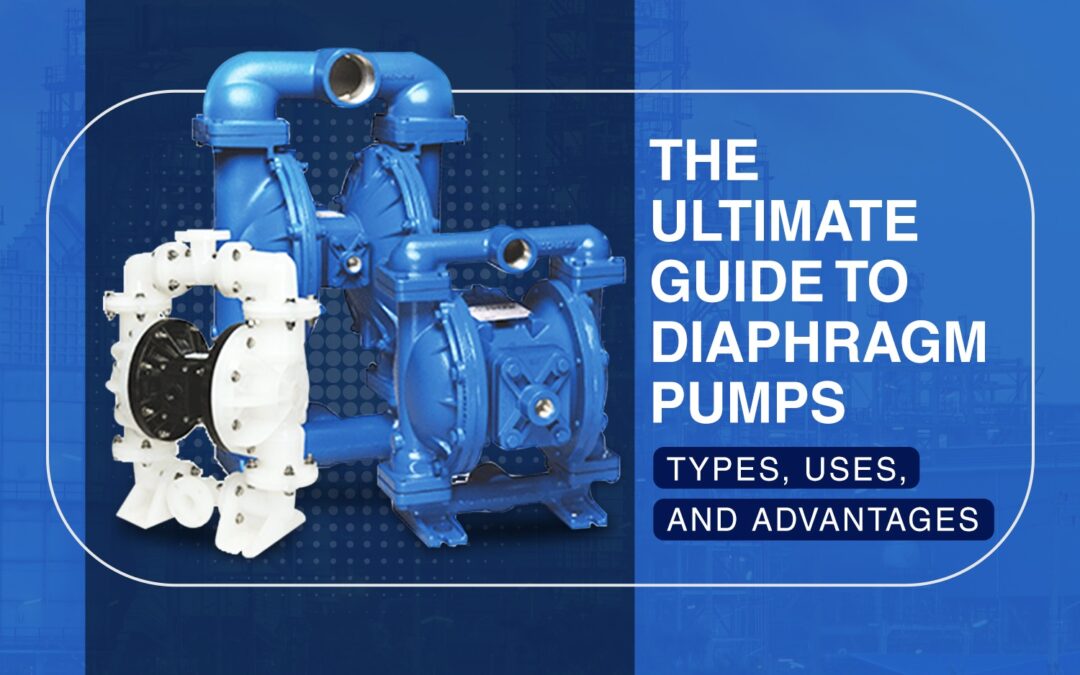Industries like chemicals, pharma, water treatment, and food processing rely heavily on fluid handling. Efficient and safe transfer of fluids keeps operations running smoothly. As these industries grow, they need pumps that can handle a wide variety of media. That includes harsh chemicals and thick slurries.
Diaphragm pumps meet this demand. They are known for their robust design and leak-free performance. These pumps handle corrosive and hazardous fluids with ease. They also adapt well to evolving industrial needs. This guide covers the types, applications, and benefits of diaphragm pumps. It also shows how innovations are pushing their capabilities further.
What Are Diaphragm Pumps?
Diaphragm pumps are positive displacement pumps. They use a reciprocating diaphragm to move fluids. Their design eliminates mechanical seals. That means no leaks.
A flexible diaphragm creates pressure during each stroke. Check valves guide the fluid in one direction. The pump chamber holds the fluid during transfer.
These pumps prevent contamination. They also ensure smooth and safe operation. That’s why they’re trusted in critical fluid applications.
Types of Diaphragm Pumps
Different tasks call for different types of diaphragm pumps. Here are the main ones:
- Air-Operated Double Diaphragm (AODD) Pumps
These pumps run on compressed air. That makes them great for explosive or hazardous zones. They can self-prime. They can also run dry without damage. They are lightweight and easy to move. That’s why they’re popular for mobile jobs.
- Electric Operated Double Diaphragm (EODD) Pumps
These pumps combine diaphragm design with electric control. They are energy-efficient. They offer precise flow control. They can also be automated for remote monitoring. That makes them ideal for modern setups.
- Hydraulic Diaphragm Pumps
These are built for high-pressure work. They offer smooth, pulse-free flow. That makes them perfect for accurate dosing. You’ll often find them in chemical plants and heavy-duty applications.
- Mechanical Diaphragm Pumps
These pumps are simple and affordable. They suit low-pressure jobs like water treatment. They are best for moderate-duty, routine tasks.
Key Applications of Diaphragm Pumps
Diaphragm pumps are used in many industries. Their flexibility is a major advantage.
- Chemical Processing
They move corrosive acids, solvents, and slurries without leaking.
- Pharma and Biotech
They handle fluids safely in sterile environments.
- Food and Beverage
They use hygienic materials. That ensures contamination-free transfer of liquids.
- Water and Wastewater Treatment
They dose chemicals precisely. They can also move sludge easily.
- Paints, Inks, and Coatings
They can handle thick and abrasive liquids without clogging.
- Mining and Construction
They are strong enough to transfer slurry and handle dewatering.
These industries rely on diaphragm pumps for reliable fluid handling.
Advantages of Diaphragm Pumps
Diaphragm pumps offer several operational benefits.
- They don’t leak. That’s critical for toxic or hazardous fluids.
- They can self-prime. No need to fill them manually.
- They handle viscous and abrasive fluids with ease.
- They can run dry. That prevents damage during fluid interruptions.
- They are portable and easy to install.
- Their modular build makes them easy to service.
- EODD models save energy. They also support automation.
All these features make diaphragm pumps reliable and cost-effective.
Also Read: Cognito EODD Pumps: The Future of Electric Operated Double Diaphragm Technology
Common Considerations When Choosing a Diaphragm Pump
Choosing the right pump requires a few checks.
- Make sure the pump materials match your fluid. PTFE and stainless steel are common choices.
- Know the viscosity and solids in your fluid. The pump must be capable of handling them.
- Define your required flow rate and pressure. That helps you size the pump properly.
- Pick a suitable drive. Air, electric, or hydraulic—each suits different environments.
- Decide if the pump should be fixed or mobile. That affects the model and size.
- Look for certifications. ATEX, FDA, and ISO may be necessary for some industries.
Choosing right ensures safety, performance, and durability.
IDEX Cognito Diaphragm Pumps: Precision Meets Innovation
IDEX brings a range of diaphragm pumps under the Cognito name. These pumps meet the latest industrial demands. EODD versions come with high-efficiency motors. They save energy and reduce running costs.
Smart sensors allow remote tracking. They also help with preventive maintenance.
Air usage is optimized. That lowers noise and extends diaphragm life. Cognito pumps serve chemical, pharma, F&B, and environmental sectors. They are versatile and dependable.
With
IDEX India, businesses get strong local support. They also get access to global-quality products. Spare parts and service are easily available. Custom solutions are available for specific needs.
Conclusion
Diaphragm pumps are essential in fluid handling. They work safely and efficiently.
Their leak-free and durable design makes them ideal for demanding jobs.
Selecting the right pump type ensures best results. That includes safety, reliability, and efficiency.
Cognito Diaphragm Pumps by IDEX India offer smart solutions. They blend innovation with dependability.
If you want to future-proof your fluid systems, Cognito is a smart choice.
Go for the pump that delivers performance without compromise. Build your operations on a strong, leak-proof foundation.
